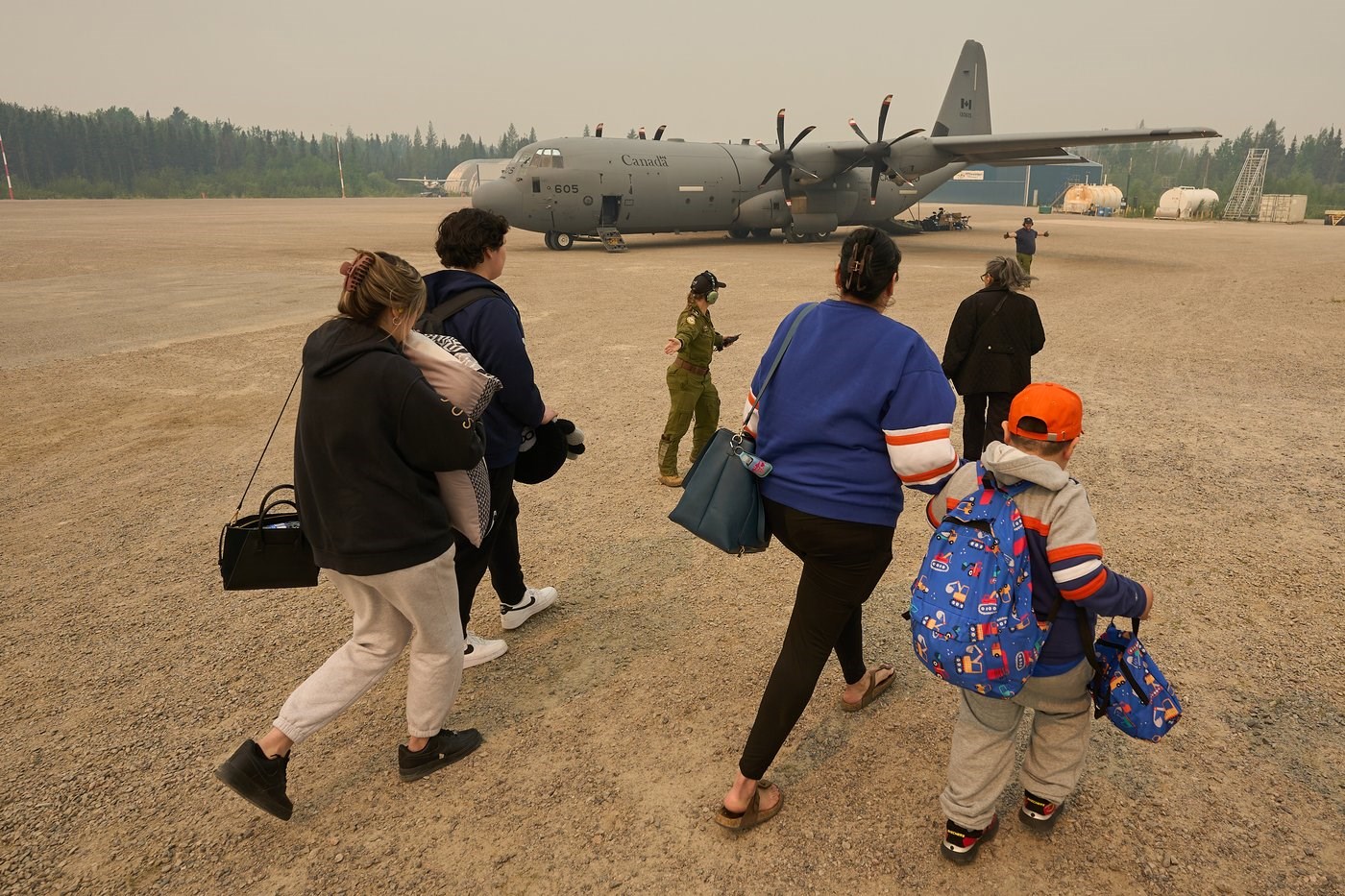
Members of the Royal Canadian Air Force help the Munroe family board a C-130 Hercules aircraft in Norway House, Man., Tuesday, June 3, 2025, at the Norway House Airport as crews continue to fight wildfires in northern Manitoba. THE CANADIAN PRESS/David Lipnowski
Republished June 05, 2025 - 4:12 PM
Original Publication Date June 05, 2025 - 1:01 AM
REGINA — Saskatchewan Premier Scott Moe is resisting an Opposition call to bring in the military to combat wildfires that have forced thousands from their homes.
In a statement Thursday, Moe’s office said they recognize the Canadian Armed Forces can play a key role in specific areas, such as aerial evacuations, but said that’s not what Saskatchewan needs right now.
“Currently, Saskatchewan’s greatest areas of need are for water bombers and firefighting resources, which the military is not able to provide,” it said.
His office noted it is keeping in touch with the federal government and is getting help from other provinces to fight the fires, along with supports from the Canadian Red Cross. Marshals are patrolling evacuated communities to prevent looting.
Earlier Thursday, the Opposition NDP called on Moe to call in the military, as has been done in Manitoba.
"Every available resource in our country must be deployed to fight these fires. We cannot afford to leave help on the table," NDP Leader Carla Beck wrote in a letter to Moe.
Saskatchewan is battling 25 active fires and estimates 400 structures have burned.
Steve Roberts, with the Saskatchewan Public Safety Agency, said there has been little rain for a month, and rain is what's needed.
"Weather continues to be problematic," Roberts told an online news conference Thursday. "Rain will be a big turning point for these fires but until then we're dug in doing the best we can."
More than 30,000 people in Saskatchewan and Manitoba have been forced to flee their homes ahead of scores of wildfires in recent days, more than 18,000 from Manitoba alone.
Smoke from the Prairie wildfires has drifted as far east as Newfoundland and Labrador, and as far south as Florida in recent days, prompting health warnings in some regions.
The major evacuation zones are in and around La Ronge, Sask., where 7,000 have been forced out, and in the city of Flin Flon, Man., where all 5,000 city residents along with another thousand in the surrounding vicinity have had to leave.
The Canadian Red Cross set up an emergency evacuation centre in Regina providing meals and a place to stay.
Darin Cook was waiting outside the centre with his family for a taxi to a hotel. He said they took a bus Thursday at midnight from Stanley Mission, northeast of La Ronge.
“There were fires all along the highway, a lot of hotspots all over,” he said. “Everyone was in a rush (to get out).”
Fred Cook, also from Stanley Mission, said it was extremely smoky. He’s planning to stay with his daughter in Regina, he added.
“It’s pretty hard for the kids (to leave), especially the babies,” he said.
The fires have also displaced about 6,700 in the Pimicikamak Cree Nation in north-central Manitoba.
Pimicikamak Chief David Monias said additional help is coming to his community after he joined other First Nations leaders in calling for adequate equipment and resources.
Monias said in a post on social media a crew of 30 to 35 structural firefighters, along with six pumpers, tankers and command teams, are being deployed to the community.
Manitoba has 27 active wildfires, a third of which are out of control. Provincial officials said weather and firefighters from Manitoba and elsewhere are keeping the fires from overrunning communities for now.
“The weather over the last couple of days has improved our ability to get some pretty good progress done on these fires," said Kristin Hayward with the Manitoba Wildfire Service.
“We have had cooler temperatures, a little bit higher humidity (and) winds generally have been low to moderate. We are expecting that general trend to continue.”
In Winnipeg, police say they will help out to protect evacuees who are unfamiliar with large urban centres and could be prey for exploiters or scammers.
The leader of the organization that represents the northern First Nations that have been evacuated said some of the main concerns are around drug and human trafficking and sexual violence.
“This is proactive effort and not reacting until after it happens. This is making that step to make sure our people are protected,” said Grand Chief Garrison Settee of Manitoba Keewatinowi Okimakanak.
Manitoba and Saskatchewan declared states of emergency last week to allow various levels of government to co-ordinate resources and support.
In northern Alberta on Thursday, the approximately 1,300 residents of the town of Swan Hills were allowed to return to their homes about a week after fleeing from a wildfire.
But about 340 kilometres west in the County of Grande Prairie, people were ordered out.
Earlier this week, officials with the Municipal District of Opportunity, which covers a dozen small rural communities in northern Alberta, confirmed that roughly half of the structures in Chipewyan Lake had been destroyed by a wildfire on the weekend.
Marcel Auger, reeve of the district, said on social media Tuesday that 38 structures were destroyed, including the community health centre, water treatment plant and homes.
Chipewyan Lake has 75 people.
Liam Buchart, a fire weather specialist with Natural Resources Canada, says wildfires on the Prairies became severe more quickly than normal this week.
"The second half of May dried out slightly earlier than normal across a lot of the Prairies," he said. "We're at our second-largest area burned for this time of year in the last decade at least."
— With files from Brittany Hobson in Winnipeg and Jack Farrell and Fakiha Baig in Edmonton
This report by The Canadian Press was first published June 5, 2025.
News from © The Canadian Press, 2025